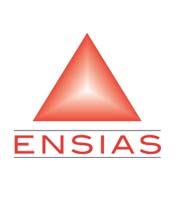- Accueil
-
L'Ecole
-
FORMATIONS
-
FORMATION INGENIEUR
-
Nouvelles filières offertes
- Ingénierie Intélligence Artificielle (2IA)
- Smart Supply Chain & Logistics (2SCL)
- Business Intelligence & Analytics (BI&A)
- Génie de la Data (GD)
- Génie Logiciel (GL)
- Ingénierie Digitale pour la Finance (IDF)
- Smart System Engineering (SSE)
- Data and Software Sciences (D2S)
- Cybersécurité, Cloud et Informatique Mobile (CSCC)
- REGLEMENT DES ETUDES DE L’ENSIAS CYCLE INGENIEUR
-
Nouvelles filières offertes
-
FORMATION INGENIEUR
- FORMATION CONTINUE
-
Recherche
- INTERNATIONAL
- ENTREPRISES
- VIE ESTUDIANTINE
- BIBLIOTHEQUE
LES DERNIÈRES INFORMATIONS
M. Si Lhoussain AOURAGH

Département:
Présentation:
Professeur d'Enseignement Supérieur
Doctorat à l’Université Mohammed premier de Oujda, sous le thème : « Modèles stochastiques de langage pour la génération automatique des phrases en langue arabe »
Membre de filière d’Ingénierie Intelligence Artificielle,
Ex-enseignant chercheur à la faculté des sciences Dhar Lmahraz, Fès,
Ex-enseignant chercheur à la FSJES de Salé,
Président de l’Association de l’Ingénierie de la Langue Arabe au Maroc.
Site web : https://www.aouragh.ma/
Thèmes de recherche:
- Natural Language Processing : Génération automatique des phrases, Modèles de langage, étiquetage automatique, correction automatique, recherche d’information, classification, question/réponse, analyse des sentiments….
- Enquêtes et Analyse des données,
Matières enseignées:
Statistique Descriptive, Statistique Inférentielle, Analyse des Données, Machine Learning, Deep Learning, Natural Language Processing (NLP), Probabilités, Econométrie, Recherche Opérationnelle, Techniques d’Enquêtes, Mathématiques Financières, Informatique de Gestion
Publications:
Chapitres du livre
1. « The Large Annotated Corpus for the Arabic Language (LACAL) », In: Al-Emran, M., Shaalan, K. (eds) Recent Innovations in Artificial Intelligence and Smart Applications. Studies in Computational Intelligence, vol 1061. Springer, Cham 2022.
The Large Annotated Corpus for the Arabic Language (LACAL) | SpringerLink
2. « Improving Arabic Lemmatization through a lemmas database and a machine-learning technique », In book: Studies in Computational Intelligence: Recent advances in NLP: the case of Arabic language. November, 2019.
Improving Arabic Lemmatization Through a Lemmas Database and a Machine-Learning Technique | SpringerLink
Articles
1. « A new spell-checking approach based on the user profile », International Journal of Computing and Digital Systems ISS(3310-142X) 2023-05-06
https://journal.uob.edu.bh/handle/123456789/4934
2. « Global Spelling Correction in Context using Language Models: Application to the Arabic Language », International Journal of Computing and Digital Systems, Volume 13, No.1, 361-370 (Jan-2023)
https://journal.uob.edu.bh/handle/123456789/4748
3. « New language models for spelling correction », The internationnal Arab Journal Information Technology, N°: 9/6/32, Date 10/05/2022, Paper number 20467
https://iajit.org/portal/images/Year2022/No.6/20467.pdf
4. « Improving SpellChecking: an effective Ad-Hoc probabilistic lexical measure for general typos », Indonesian Journal of Electrical Engineering and Computer Science, pp. 521-527, 2022-07-01
https://ijeecs.iaescore.com/index.php/IJEECS/article/view/26329
5. « Survey of Arabic Checker Techniques », SUST Journal of Engineering and Computer Science (JECS), Vol 21, No 1, 2020
Survey of Arabic Checker Techniques | Saty | Journal of Engineering and Computer Science (JECS) (sustech.edu)
6. «Adaptating the Levenshtein Distance to Contextual Spelling Correction », International Journal of Computer Science and Applications, Vol. 12, N°1, pp. 127 – 133, 2015
7. «Morpho-syntactic tagging system based on the patterns words for Arabic texts », International Arab Journal of Information Technology (IAJIT); volume 8, N°4, 2011.
8. «Traitement des mots inconnus pour les systèmes d’étiquetage morpho-syntaxiques des textes arabes basés sur le modèle de Markov caché », Centre de Recherche sur l'Information Scientifique et Technique, Alger, ALGERIE, RIST ( Vol-17 n°1), 2007,
9. « A Stochastic Language Model for Automatic Generation of Arabic Sentences », Computer Science and Telecommunications, Georgian Electronic Scientific Journal, No.3 (10), 2006.
Communications
1. « A new estimate of the n-gram language model » Procedia Computer Science Volume 189, 2021, Pages 211-215.
A new estimate of the n-gram language model - ScienceDirect
2. “Automatic Identification of Moroccan Colloquial Arabic”. Arabic Language Processing: From Theory to Practice, Springer International Publishing, Cham, vol. 782, pp. 201-214, 2018.
Automatic Identification of Moroccan Colloquial Arabic | SpringerLink
3. « Spelling correction for the Arabic language -space deletion errors- » The 11th International Conference on Emerging Ubiquitous Systems and Pervasive Networks (EUSPN 2020) November 2-5, 2020, Madeira, Portugal;
Spelling correction for the Arabic language space deletion errors- - ScienceDirect
4. « Integration of data sources in an automatic corrector of Arabic texts » 4th IEEE International Colloquium on Information Science and Technology (CiSt), 2016,
Integration of data sources in an automatic corrector of Arabic texts | IEEE Conference Publication | IEEE Xplore
5. “A description and demonstration of SAFAR framework”. Proceedings of the EACL Workshop. 2021.
A description and demonstration of SAFAR framework - ACL Anthology
6. “A light Arabic POS Tagger using a hybrid approach”. In the international conference on digital technologies and applications”, January 29-30, 2021.
A Light Arabic POS Tagger Using a Hybrid Approach | SpringerLink
7. “Etude exploratoire relative aux difficultés des étudiants face aux matières quantitatives et de dissertation dans les FSJES : Le cas de la faculté de Salé. Colloque international EVLSUP 2019, 17-18 décembre 2019 à l’EST université Mohemmed Premier d’Oujda. (Attestation)
8. Distant n-gram Language Model for Contextual Spelling Correction Applied to Arabic Language. The 2nd international Conference on Embedded Systems and Artificial Intelligence (ESAI'21) held on April 01-02, 2021, at ENSA, Fez, Morocco,
9. Large Annotated Arabic Corpus. the 2022 IEEE 9th International Conference SETIT, May 28-30, 2022
10. Le mangement de la continuité pédagogique à distance à l'heure de la pandémie Covid-19: Le cas de L'Université Mohammed V de Rabat EvalSup 24-25 Juin 2020,
11. 4ème édition des journées doctorale de l’ingénierie de la langue arabe. Institut d’Etudes et de Recherches pour l’Arabisation, Rabat 6-7 Avril 2021.
12. « Intégration des sources de données dans un correcteur automatique des textes arabes», Journée d’étude: Ressources langagières de l’arabe pour le TAL : construction, standardisation, gestion et exploitation; Institut d’Etudes et de Recherches pour l’Arabisation, Rabat 2015
13. « Etude et développement d’un correcteur orthographique pour la langue Arabe », The Second National Doctoral Symposium On Arabic Language Engineering (JDILA'2015), ENSA Fès 2015
14. « Traitement automatique des mots inconnus dans les systèmes de correction des fautes d’orthographe », The Second National Doctoral Symposium On Arabic Language Engineering (JDILA'2015), ENSA Fès 2015.
15. « L'évaluation de la motivation des étudiants », Colloque international EVALSUP 2014 EST, Oujda 2014
16. « Adaptation de la distance de Levenshtein pour la correction orthographique contextuelle » 9éme Conférence Internationale sur l’Intelligence Artificielle : Théories et Applications; SITA’14, 2014. INPT, Rabat.
17. « Détection des paramètres qui influent sur la motivation des étudiants » colloque CNES'2012, 2012, FSJES, Souissi, Rabat.
18. « Adaptation d’un système d’étiquetage de la langue Arabe à l’amazighe », CEISIC 2008, Institut Royal de la Culture Amazighe, Rabat, Maroc.
19. « Modèle p-contexte de classe pour la génération automatique des phrases arabe », ICWIT’2008, 2008, L’université de Sidi Bel Abbes, Algérie.
20. « Morpho-syntactic tagging system for Arabic texts », Conférence Internationale sur les Ressources et l’Evaluation (LREC 2008), Marrakech, Maroc.
21. « Comparaison entre le modèle de langage p-contexte et le modèle de langage p-gram », CITALA’07, 2007, IERA, Rabat, Maroc.
22. « La modélisation des niveaux syntaxique et sémantique pour la génération automatique des phrases arabe », INFORSID 2006, Hammamet, Tunisie.
23. « Modèle p-contexte de classe pour la génération automatique des phrases arabe. », JETALA 2006, IERA, Rabat, Maroc.
24. « Modèle de langage stochastique pour la génération informatique des phrases en arabe », JIMIO’1 2005, Oujda, Maroc.
LIENS UTILES
Localisation
Contactez-nous
ENSIAS
 Avenue Mohammed Ben Abdallah Regragui, Madinat Al Irfane, BP 713, Agdal Rabat, Maroc
Avenue Mohammed Ben Abdallah Regragui, Madinat Al Irfane, BP 713, Agdal Rabat, Maroc
![]() Télécopie : (+212) 5 37 68 60 78
Télécopie : (+212) 5 37 68 60 78
![]() Secrétariat de direction : 06 61 48 10 97
Secrétariat de direction : 06 61 48 10 97
Secrétariat général : 06 61 34 09 27
Service des affaires financières : 06 61 44 76 79
Service des affaires estudiantines : 06 62 77 10 17 / n.mhirich@um5s.net.ma
CEDOC ST2I : 06 66 39 75 16
Résidences : 06 61 82 89 77
- Compteur de visiteurs:631,529
Education - This is a contributing Drupal Theme
Design by WeebPal.
Design by WeebPal.



































